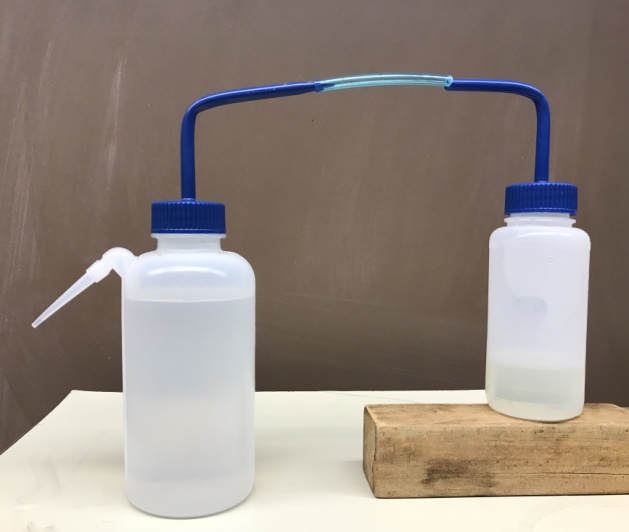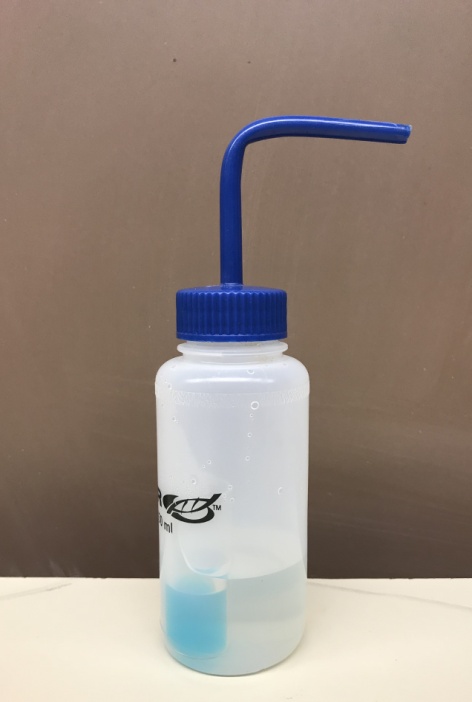-
Paper Information
- Paper Submission
-
Journal Information
- About This Journal
- Editorial Board
- Current Issue
- Archive
- Author Guidelines
- Contact Us
Journal of Laboratory Chemical Education
p-ISSN: 2331-7450 e-ISSN: 2331-7469
2018; 6(1): 18-20
doi:10.5923/j.jlce.20180601.04

Simplicity and Elegance of the Wash Bottle in Water Displacement Schemes
Frazier Nyasulu, Rebecca Barlag, Lauren McMills, Whalmany Ounkham, Phyllis Arthasery
Department of Chemistry and Biochemistry, Ohio University, Athens, OH, United States
Correspondence to: Frazier Nyasulu, Department of Chemistry and Biochemistry, Ohio University, Athens, OH, United States.
| Email: |  |
Copyright © 2018 Scientific & Academic Publishing. All Rights Reserved.
This work is licensed under the Creative Commons Attribution International License (CC BY).
http://creativecommons.org/licenses/by/4.0/

Wash bottles greatly simplify the determination of the volume of a gas produced by a chemical reaction using a water displacement scheme. A versatile and elegant system consisting of two wash bottles is described.
Keywords: Water Displacement, Gas Producing Reactions, General Chemistry
Cite this paper: Frazier Nyasulu, Rebecca Barlag, Lauren McMills, Whalmany Ounkham, Phyllis Arthasery, Simplicity and Elegance of the Wash Bottle in Water Displacement Schemes, Journal of Laboratory Chemical Education, Vol. 6 No. 1, 2018, pp. 18-20. doi: 10.5923/j.jlce.20180601.04.
1. Introduction
- Water displacement schemes are widely used in entry-level chemistry labs to determine the volume of gases produced by chemical reactions [1-10]. The popularity is due in part to the simplicity of the setup with items ordinarily available in teaching laboratories. The classic water displacement setups are shown in Figure 1, with examples of gas collector systems on the right and gas generator reaction systems on the left.
 | Figure 1. Classic water displacement schemes |
 | Figure 2. Water displacement scheme consisting of two wash bottles |
2. New Water Displacement Scheme
- The smaller wash bottle is a standard wash bottle (reactor) and the larger one is a unitary wash bottle (collector). The cover on the unitary wash bottle is that from a standard wash bottle. In both wash bottle covers, the internal outflow tube is removed. Gelatin capsules can be used when one of the reagents is a solid. One classic experiment using water displacement schemes is the identification of an unknown metal [7, 8]. The metal is reacted with excess HCl (aq) and the volume of the H2 (g) is determined. The H2 (g) pressure is equal to the atmospheric pressure and the temperature of the H2 (g) is equal to the room temperature. The amount of gas is calculated according to the ideal gas law and the moles of metal are calculated assuming a +2 metal ion charge. From the mass of the metal and the moles of metal, the molar mass of the metal is calculated. Using the setup in Figure 3, students determined the molar mass of an unknown metal to be 24.3 ± 0.2 g/ mol (N = 9) and thereby unambiguously identified the metal as magnesium.
 | Figure 3. Procedure to mix two solutions |
3. Conclusions
- Wash bottles allow students to accurately determine the volume of gas produced by chemical reactions. The mass of the gas produced can be determined by subtracting the mass of the product system from the mass of the reaction system. The density of the gas can then be calculated, which in turn can be used to calculate the molar mass of the gas. When reagents are not known, students can identify the gas produced. If the pressure (typically equal to the atmospheric pressure) and temperature (typically equal to the room temperature) of the gas are also measured, the moles of gas can be calculated, which can then open up a number of follow-up exercises. For example, the ideal gas law constant can be determined within 5% of the literature value [9]. There are many possible applications of wash bottle water displacement schemes. Some examples appear in the manuscript A Simple, Safe, and Easy Water Displacement Exercise for the Identification of Two Metals and the Composition of a Mixture in this journal.The simplicity of these setups allows for repetition of runs and therefore enables meaningful statistical analyses to be performed. Additionally, this method is cost effective due to the use of plastic wash bottles, smaller reagent(s) volumes, and a reduction in chemical waste. Plastic wash bottles remove the need for glassware, improving safety in the laboratory. Overall, these setups are simple, cost effective, and environmentally friendly.
 Abstract
Abstract Reference
Reference Full-Text PDF
Full-Text PDF Full-text HTML
Full-text HTML